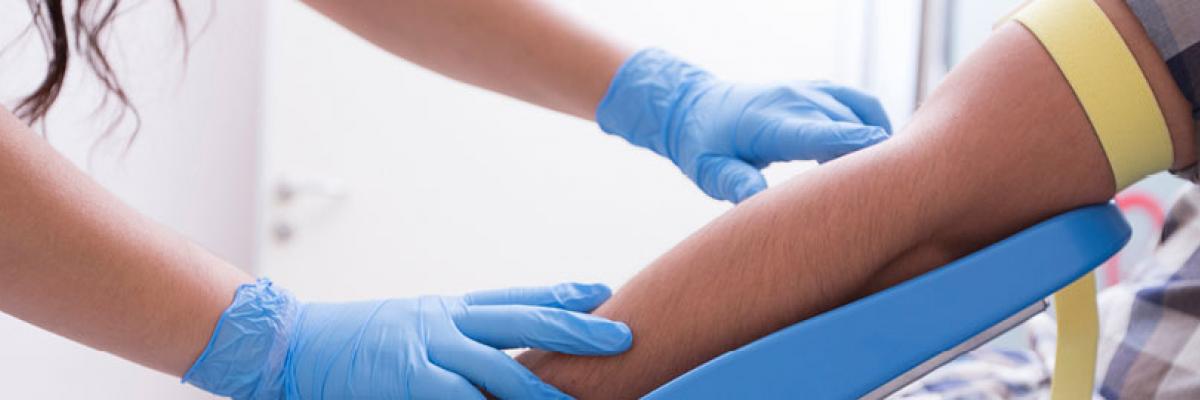The blood needed for a diagnostic test is usually fairly easy to obtain using a procedure called venipuncture (a term which quite simply means "puncturing the vein"). The person performing this procedure may be your doctor, a nurse, or someone specfically trained in collecting blood samples called a phlebotomist.
Phlebotomists who work in hospitals, cancer clinics, and outpatient settings perform many venipunctures each day, experience that quickly makes them good at handling difficult situations and distressed individuals. The phlebotomist knows how to put patients at ease, knows how to assist someone who is feeling lightheaded or faint.
Knowing that the person collecting the sample has undergone thorough training and demonstrated a high level of competency can help a nervous patient relax.
What Will Happen? During venipuncture, the phlebotomist inserts a needle through your skin into a vein. The amount of blood needed for the test is withdrawn through the needle into a special tube or tubes. The tubes are sent to a laboratory where the blood is analyzed as your doctor has requested. Most often, the phlebotomist is able to identify a vein in the crook of your elbow that will be easily accessible and applies a tourniquet above the site to make the vein more apparent, (the elbow area does not have many nerves so this is a good site; the wrist, hand and foot are other sites that can be used). Clenching your fist, when you are asked to, helps make the vein more prominent. The procedure usually takes less than 3 minutes. Afterward, the patient, or carer, is usually asked to apply gentle pressure, over a clean dressing, to help the blood clot and prevent swelling and bruising.
Will It Hurt? When the needle is inserted under the skin, you might feel a slight sting, and there may be additional discomfort when it is withdrawn. If you are accompanying a child or an anxious patient, it helps to explain that he or she will feel momentary pain or discomfort. Don’t say, "This won't hurt a bit", because the patient will then have reason to mistrust the people and situation when it does sting. Be honest, create a reasonable expectation, and you will really help the patient.
Not Flowing Well? Drinking 8 to 10 glasses of liquid a day helps blood flow better and makes the veins more likely to stick up and be found easily, so drink plenty of fluids for a day or two before your test. But, also, remember to follow your doctor’s instructions - some tests require that you not drink certain liquids prior to the test. You may also want to take a walk while waiting, or on your way to the test, to increase blood flow and keep the veins pumped up (routinely doing hand and arm exercises also helps those requiring frequent testing). Even eating well the day before, if fasting is not required, improves blood flow.
Dry Skin? Applying a moisturizer at least 4 times a day from the hand to the elbow (or wherever you expect the skin will be punctured) can make the puncture less painful. Lotions work best when applied just after the skin has just been wet, for example after bathing, showering, swimming, or washing dishes.
Cold Hands? Being warm increases your blood circulation, which makes it easier for the phlebotomist to find a vein. While you are waiting, you may want to leave your coat or sweater on and let your arm dangle down to increase the blood pressure in the veins. If you have difficulty with blood being taken, lying down and warming your hands under a heating pad and blanket usually provide good results.
Getting Anxious? Talk about or recall something pleasant while you wait to take your mind off your anxiety; you can also bring interesting reading, music, or even relaxation tapes to listen to on a portable CD or tape player.
Feeling Faint? If you are nervous or have a tendency to feel woozy or faint, tell the phlebotomist before you begin. Your blood can be taken while you are lying down, which will help you avoid fainting and injuring yourself. If, at any time, you feel faint or lightheaded, tell the phlebotomist or someone nearby. Putting your head between your knees or lying down should make you feel better soon.
Can't You Find the Vein? If the phlebotomist does not succeed in reaching the vein, another phlebotomist may step in to complete the procedure. This keeps both the patient and the phlebotomist from becoming flustered and should be seen as a reassuring step.
What Helps Afterward? If you experience swelling, bruising, or pain, follow general first-aid procedures to relieve the pain, including putting ice on the site, using the affected arm as little as possible, and taking a pain killer if that is an allowable medication for you.


